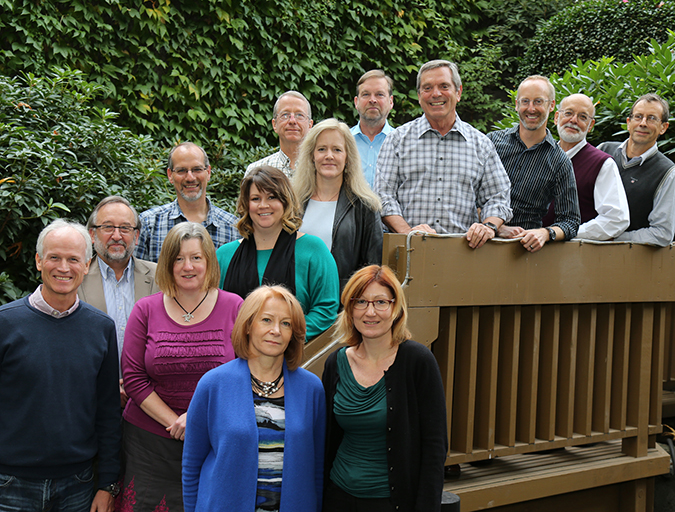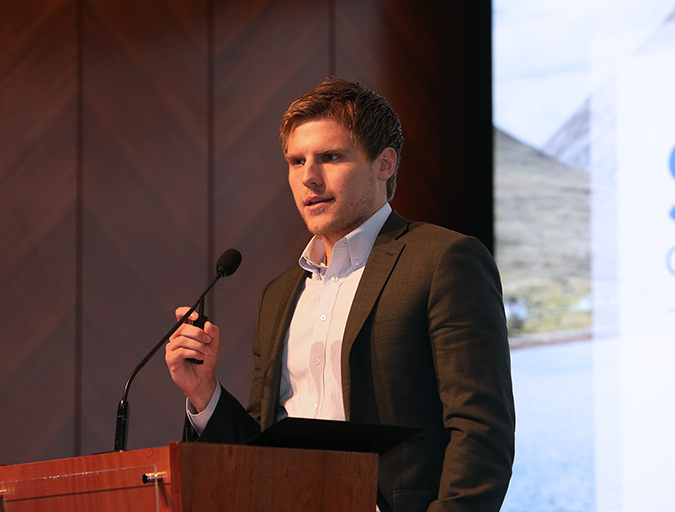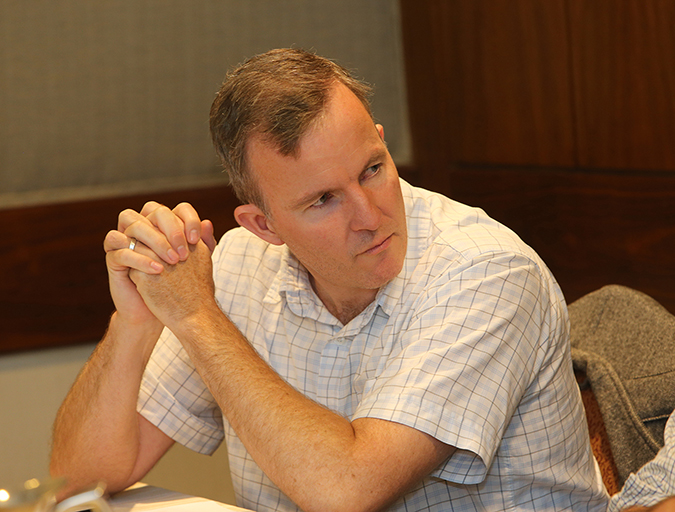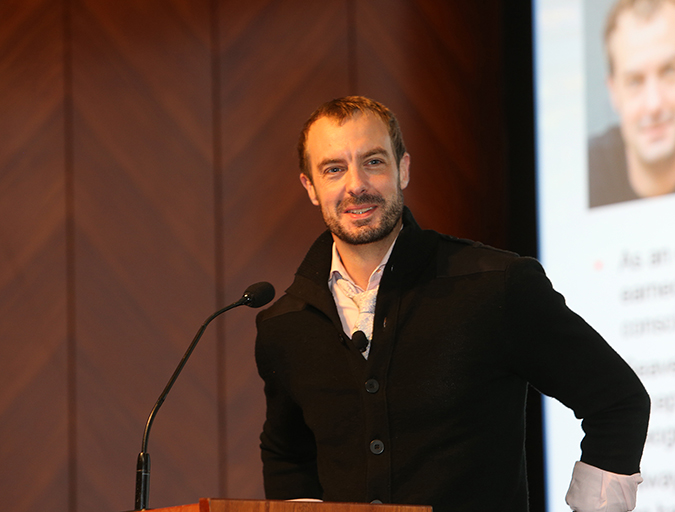Annual aquaculture leadership conference reveals an industry eager to improve
Canada’s national anthem closes with the stirring patriotic vow, “we stand on guard for thee!” Aquaculture leaders from around the world gathered on Day 1 of the 2015 GOAL conference in Vancouver, British Columbia, Canada, to demonstrate how they protect their industry from repeating mistakes of the past while looking to the future with confidence.
At the conclusion of the song that kicked off the three-day event, a Squamish Nation ceremony led by Chief Maurice Nahanee and The Chinook Song Catchers convinced the 400-plus attendees from across the seafood value chain that Canada was an eager and fitting host.
With the industry still striving to meet its aggressive goal to double global production within a decade (a goal set five years ago at this very event), Global Aquaculture Alliance Executive Director Wally Stevens began the program with his “Professor Stevens” report card. “As an industry we have a lot of work cut out for us,” he said, slicing into his onion-layer metaphor to describe the eight challenges to the aforementioned growth goal.
Stevens’ grades on how those challenges have been met? Probably not good enough to get into a good college: disease (D), feed (C), environment (B), social responsibility (D), market support (B), investor support (C), leadership (incomplete) and consumer awareness (C). The ninth challenge — education — will surely echo through the halls of the Four Seasons Hotel until GOAL is finished.
As it turns out, Stevens concluded, doubling global production will take closer to 15 years: “Still quite an achievement,” he said.
Keynote speaker Jon Hindar, the CEO of the world’s second-largest farmed salmon producer Cermaq, spoke of the industry’s role in addressing the global sustainability challenges, megatrends in food demand and how an industry often-maligned in the media can reach consumers to address their concerns with transparency and active engagement. Salmon farmers’ responsibility should extend industry-wide, he said.
“Since 2010, [farmed salmon] consumption has increased 40 percent,” said Hindar. “What’s good for you is also good for the planet.” Salmon farming is the “most technically advanced seafood production in terms of vaccines, feed and technical equipment,” and Hindar pledged to transfer “vital competence and technology to advance aquaculture in other species.”
It’s always difficult to see what the next sensational issue will be. I would not be complacent. We need to coalesce and message that or it will be messaged for us.
Later in the day, the British Columbia Salmon Farmers Association released its first annual sustainability progress report (click here for related article). The industry in the host province has set a goal of zero antibiotic use, said Executive Director Jeremy Dunn.
All aquaculture producers are playing defense against diseases: Hindar spoke about the need to improve biosecurity measures in the transport of live fish, and in sea lice prevention. His remarks were followed by a panel of disease-solution experts, including Robins McIntosh, Senior VP at Charoen Pokphand Group Co. Ltd., who said that EHP (Enterocytozoon hepatopenaei) poses a bigger long-term risk to the farmed shrimp industry than EMS (Early Mortality Syndrome), a disease that slowed the annual global shrimp production rate by 14 percent from 2011 to 2013 (according to James Anderson, Director, Institute for Sustainable Food Systems and Professor, Food & Resource Economics, University of Florida, who presented later in the day).
“[EHP] is difficult to disinfect. It’s carried like a virus. Once it gets into ponds, spores get into the pond bottom. Detection is so difficult. This happens a lot now. Most (Southeast Asia) hatcheries are infected with EHP. You got to have clean broodstock, clean the hatchery, then you have to disinfect the pond. This is not easy on a large scale,” McIntosh said emphatically. The recent disease storm in Thailand, however, is “abating … and it’s not luck,” he concluded.
The marketplace is aware of the “threats” to the supply chain, commented Huw Thomas, Fisheries and Aquaculture Manager at UK-based retailer Morrisons during a roundtable discussion, stopping short of calling out any major concerns. Retailers and restaurant operators are the ones on the front lines, so to speak, when it comes to confronting consumers’ fears about farmed fish. More than a dozen are scheduled to speak at this year’s conference.
“It’s always difficult to see what the next sensational issue will be. I would not be complacent. We need to coalesce and message that or it will be messaged for us,” said Charlie Lousignont, Senior VP-Supply Chain Management for U.S. foodservice operator Brinker International.
While the entire aquaculture value chain prepares for the next crisis to come along, the consistent collaborative effort over time will be assuring the public that farmed seafood is wholesome, nutritious and safe to eat. Stevens challenged all attendees to join a collaborative educational effort. With negative or poorly researched news articles finding new audiences in the Internet era, the task will be large, and require all stakeholder involvement. But judging from the spirit displayed during the first day of GOAL, there seems to be plenty of fight in aquaculture.
“We need to have a strong commitment to sustainable practices, a dedication of resources and time,” said Hindar. “Business as usual is no longer an option. If the industry is to expand its social license, the way we operate has to improve. By working together — we can share knowledge on how to best protect the environment and improvements can be made faster and more effectively.”
Now that you've reached the end of the article ...
… please consider supporting GSA’s mission to advance responsible seafood practices through education, advocacy and third-party assurances. The Advocate aims to document the evolution of responsible seafood practices and share the expansive knowledge of our vast network of contributors.
By becoming a Global Seafood Alliance member, you’re ensuring that all of the pre-competitive work we do through member benefits, resources and events can continue. Individual membership costs just $50 a year.
Not a GSA member? Join us.
Author
-
James Wright
Editorial Manager
Global Aquaculture Alliance
Portsmouth, NH, USA[103,114,111,46,101,99,110,97,105,108,108,97,97,103,64,116,104,103,105,114,119,46,115,101,109,97,106]
Tagged With
Related Posts

Responsibility
In pictures: GAA Standards Oversight Committee
The Global Aquaculture Alliance's Standards Oversight Committee (SOC) met on Saturday, Oct. 24, 2015, at the Four Seasons Hotel in Vancouver, British Columbia, Canada. GAA's annual GOAL conference will be held at the hotel this week.

Innovation & Investment
In pictures: Faces of GOAL 2015 (pt. 2)
The Global Aquaculture Alliance held its annual GOAL conference at the Four Seasons Hotel in Vancouver, British Columbia, Canada. Photos by Gail Hannagan, Preferred Freezer Services.

Innovation & Investment
In pictures: Faces of GOAL 2015 (pt. 1)
The Global Aquaculture Alliance held its annual GOAL conference at the Four Seasons Hotel in Vancouver, British Columbia, Canada. Photos by Gail Hannagan, Preferred Freezer Services.

Innovation & Investment
GOAL 2015 Day 2: The story we choose to tell
If Day 1 of GOAL 2015 was all about defense, the following day of the aquaculture industry’s leading global conference was about offense — exuding confidence that farming fish is the way to feed future generations, and determining how to tell the world its story.




